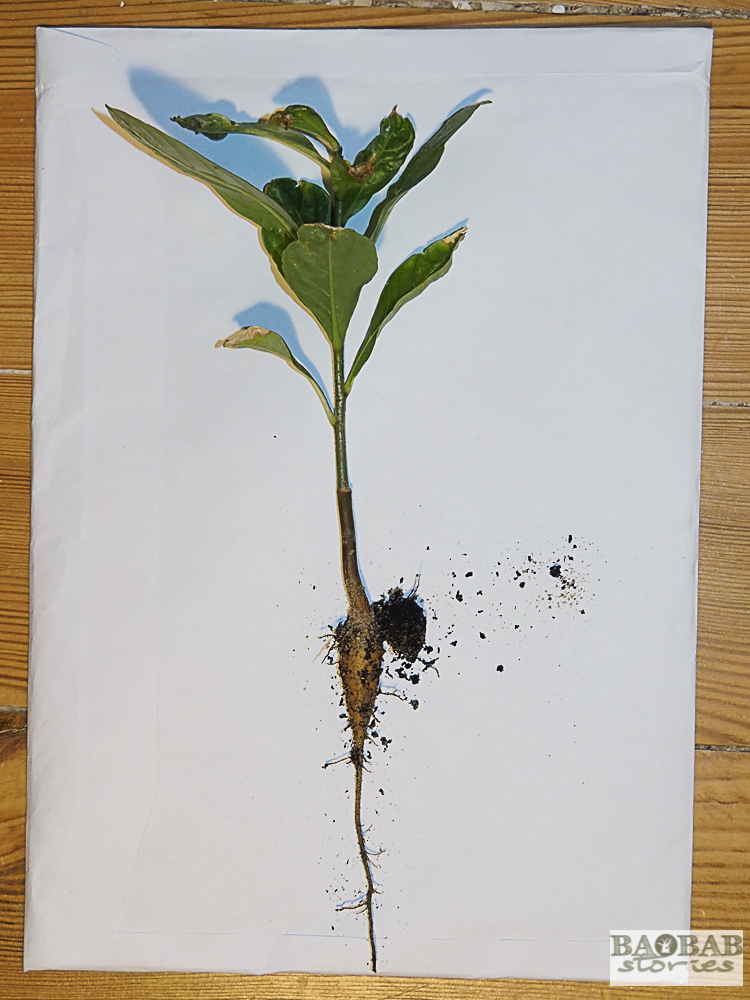The days are getting longer and my baobabs enjoy the sunshine on their windowsill in the living room. More daylight and the warmth bring out fresh green baobab leaves. Little tips appear at the ends of the branches. However, it can take a while until the leaves unfold fully.
As the cooler weather approaches, it’s important for baobab tree owners to start thinking about winter preparation. The iconic baobab is well-known for its massive trunk and drought-tolerant nature, but it still requires special care to thrive through the winter months. Follow this guide to learn everything you need to know about getting your baobab ready for winter.
Assess Tree Health
Before winter arrives, closely inspect your baobab to check for signs of pests, disease, or other issues Look for damaged limbs, yellowing leaves, spots on the bark, and frass or webbing which could indicate infestations Address any problems promptly so they don’t worsen over winter. Having your tree in top shape will give it the best chance of staying healthy when temperatures drop.
Prune Branches
Pruning your baobab in late summer or early fall encourages vigorous growth next season. Remove any dead branches and those touching or crossing over each other to improve air circulation. Good air flow reduces moisture retention helping prevent fungal diseases. Limit pruning to smaller branches – severe pruning stresses the tree. Disinfect pruners between each cut to avoid spreading disease.
Apply Protective Mulch
Mulching around the base of your baobab provides insulation for the roots and prevents soil from freezing. Use 2-4 inches of shredded bark, leaves, straw or other organic material. Ensure the mulch isn’t touching the trunk to prevent moisture accumulation and rotting. Mulch also conserves water – vital for baobabs during winter when rainfall is limited.
Monitor Soil Moisture
Baobabs are adapted to drought, but don’t allow soils to completely dry out over winter. Use your finger to check moisture 1-2 inches below the surface and water deeply if the top few inches are dry. Avoid overwatering, as wet soils lead to root rot. In very cold regions, lay burlap over soil to protect surface roots from freezing.
Move Potted Specimens Indoors
If your baobab is container-grown, move it to a sunny, sheltered location before temperatures drop below 40°F. A cool greenhouse or enclosed porch are ideal overwintering spots. Indoors near a sunny window also works. Keep indoor baobabs above 60°F – cooler temperatures may cause leaf drop. Mist leaves occasionally with water to simulate humidity.
Wrap Trunk Against Frost
In areas prone to hard freezes, wrap trunks with burlap or commercial tree wrap to protect from frost cracks. Leave the material loose enough to allow air flow. For added insulation, stuff leaves between the wrap and trunk. Remove materials in early spring after final frost risk passes. For small baobabs, cover with frost cloth on cold nights.
Apply Pre-Winter Fertilizer
Boosting nutrition before dormancy promotes vigorous spring growth. In early fall, apply a balanced, slow-release fertilizer formulated specifically for trees per label directions. Avoid high nitrogen types that spur excessive foliar growth susceptible to cold damage. Rake any fertilizer off mulched areas so it doesn’t burn roots over winter.
Provide Winter Shelter
For protection from cold winds, situate potted baobabs against a sheltered wall or in a group planting with other trees. Stake tall specimens to prevent toppling from winter storms. Cover smaller plants with burlap if hard freezes are forecast. An outdoor holiday lighting strand also generates a bit of heat.
Clean Up Leaf Litter
Rake up fallen leaves around your baobab to remove overwintering sites for pests and fungus spores. Leaf litter can also attract rodents who may chew on bark. Compost or dispose of debris – don’t pile close to the trunk. A clean area allows for easier spring inspection for new problems.
Check for Pest Activity
Monitor closely for pests like borers and bark beetles which overwinter in trees then re-emerge in spring. Watch for small holes, frass and other signs of infestation. Prune out borer tunnels and apply registered pesticides if needed before insects become active again in warm weather.
Inspect Regularly
Check your winterized baobab every few weeks and after major storms. Look for limb breakage, tilting trunks, lifted soil, animal damage or other issues and remedy immediately to prevent further injury before spring. Assessing overwintering health means you can start the new growing season off right.
Preparing baobabs properly for winter is key to their health, particularly when grown outside their native African ranges. With attention to care guidelines like pruning, fertilizing, moisture monitoring, and frost protection, your baobab will sail through the colder months and thrive when warmer weather returns.

Colour of baobab leaves
In healthy trees, the color of the leaves is a strong green, in some even dark green. Freshly emerging leaves are light green, but darken over time. If leaves take on a yellowish tinge they might suffer from different causes.

Root rot can be seen on baobab leaves
At a later stage the results of root rot can be seen on the leaves, too. Unlike the regular coloration of leaves in autumn, they get spots of a darker brown, may shrink and fall off. Sometimes only the leaf tips get dark brown and dry. If one of the baobabs has caught root rot it needs to be isolated from the other trees and taken out of the pot. Either replant the baobab in a new pot or clean the old pot thoroughly and replant in new soil. But before replanting the baobab, make sure to remove affected parts completely.

After a treatment like this the tree stands a chance to survive. Small baobabs have more problems to survive root rot as they do not have much root to cut yet. In any case it is best if root rot does not occur at all. Make sure that the soil has good water drainage and water baobabs reasonably. The best choice of soil is either a mixture of soil and river sand or ready-made cactus soil.

Rainwater is the best option for watering baobabs because it is often less calcareous than tap water. The amount of water needed is an estimation. Usually, I pour about 300 to 400 milliliters in a pot of approximately 24 centimeters in diameter. If water collects in the drip tray below I pour it out. As a matter of fact I do not water again before the soil in the pot is dry. An easy method to check this is by poking a finger into the ground. If the soil feels dry around the roots the tree needs water.

How to grow a Baobab tree from seed. Full tutorial. #gardening #baobab #tree
FAQ
Can baobab trees survive winter?
How do you prune a baobab tree?
How to save a baobab tree?
What can you do with baobab leaves?
How to overwinter a baobab tree?
You’ll need to do a lot of care to overwinter it. Place it indoors, in a bright and warm position near a windowsill. Try to keep temperature around 10 C, lower than this will stunt baobab. In winter, baobab tree drops its leaves and goes to dormancy. During this time water sparingly, watering in winter can cause root rot. Also stop to fertilize.
How do you plant a baobab tree?
It is best to plant your baobab tree in a sunny location that receives at least six hours of direct sunlight each day. Additionally, the soil should be well-draining, as the baobab tree is not tolerant of wet, water-logged soils. The soil should also be nutrient-rich and slightly acidic, with a pH between 5.5 and 7.5.
How do you care for a baobab tree?
Place it indoors, in a bright and warm position near a windowsill. Try to keep temperature around 10 C, lower than this will stunt baobab. In winter, baobab tree drops its leaves and goes to dormancy. During this time water sparingly, watering in winter can cause root rot. Also stop to fertilize. In the spring, place it back at its usual location.
When should you water a baobab tree?
Watering: only when plants are in leaf and growing over summer; withhold water from April–December. The baobab has a bottle-shaped trunk (known as a caudex) that, unlike “normal” trees, is filled with soft fibrous wood that allows it to store water. The tree may reach to 10–12m with a spread of branches at its top.
